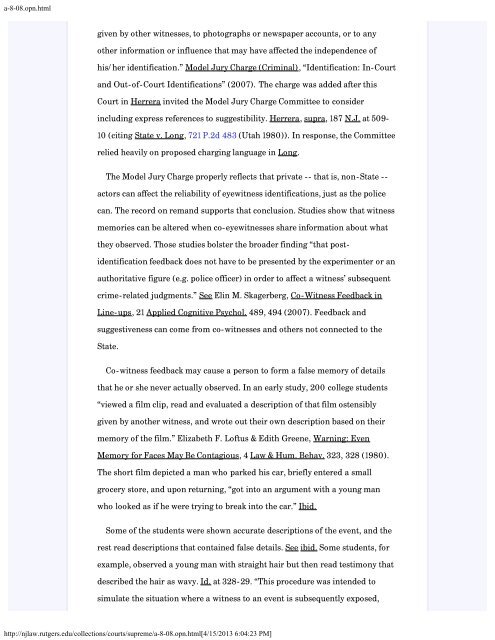State v. Henderson and the New Model Jury Charges - New Jersey ...
State v. Henderson and the New Model Jury Charges - New Jersey ...
State v. Henderson and the New Model Jury Charges - New Jersey ...
You also want an ePaper? Increase the reach of your titles
YUMPU automatically turns print PDFs into web optimized ePapers that Google loves.
a-8-08.opn.html<br />
given by o<strong>the</strong>r witnesses, to photographs or newspaper accounts, or to any<br />
o<strong>the</strong>r information or influence that may have affected <strong>the</strong> independence of<br />
his/her identification.” <strong>Model</strong> <strong>Jury</strong> Charge (Criminal), “Identification: In-Court<br />
<strong>and</strong> Out-of-Court Identifications” (2007). The charge was added after this<br />
Court in Herrera invited <strong>the</strong> <strong>Model</strong> <strong>Jury</strong> Charge Committee to consider<br />
including express references to suggestibility. Herrera, supra, 187 N.J. at 509-<br />
10 (citing <strong>State</strong> v. Long, 721 P.2d 483 (Utah 1980)). In response, <strong>the</strong> Committee<br />
relied heavily on proposed charging language in Long.<br />
The <strong>Model</strong> <strong>Jury</strong> Charge properly reflects that private -- that is, non-<strong>State</strong> --<br />
actors can affect <strong>the</strong> reliability of eyewitness identifications, just as <strong>the</strong> police<br />
can. The record on rem<strong>and</strong> supports that conclusion. Studies show that witness<br />
memories can be altered when co-eyewitnesses share information about what<br />
<strong>the</strong>y observed. Those studies bolster <strong>the</strong> broader finding “that postidentification<br />
feedback does not have to be presented by <strong>the</strong> experimenter or an<br />
authoritative figure (e.g. police officer) in order to affect a witness’ subsequent<br />
crime-related judgments.” See Elin M. Skagerberg, Co-Witness Feedback in<br />
Line-ups, 21 Applied Cognitive Psychol. 489, 494 (2007). Feedback <strong>and</strong><br />
suggestiveness can come from co-witnesses <strong>and</strong> o<strong>the</strong>rs not connected to <strong>the</strong><br />
<strong>State</strong>.<br />
Co-witness feedback may cause a person to form a false memory of details<br />
that he or she never actually observed. In an early study, 200 college students<br />
“viewed a film clip, read <strong>and</strong> evaluated a description of that film ostensibly<br />
given by ano<strong>the</strong>r witness, <strong>and</strong> wrote out <strong>the</strong>ir own description based on <strong>the</strong>ir<br />
memory of <strong>the</strong> film.” Elizabeth F. Loftus & Edith Greene, Warning: Even<br />
Memory for Faces May Be Contagious, 4 Law & Hum. Behav. 323, 328 (1980).<br />
The short film depicted a man who parked his car, briefly entered a small<br />
grocery store, <strong>and</strong> upon returning, “got into an argument with a young man<br />
who looked as if he were trying to break into <strong>the</strong> car.” Ibid.<br />
Some of <strong>the</strong> students were shown accurate descriptions of <strong>the</strong> event, <strong>and</strong> <strong>the</strong><br />
rest read descriptions that contained false details. See ibid. Some students, for<br />
example, observed a young man with straight hair but <strong>the</strong>n read testimony that<br />
described <strong>the</strong> hair as wavy. Id. at 328-29. “This procedure was intended to<br />
simulate <strong>the</strong> situation where a witness to an event is subsequently exposed,<br />
http://njlaw.rutgers.edu/collections/courts/supreme/a-8-08.opn.html[4/15/2013 6:04:23 PM]
















